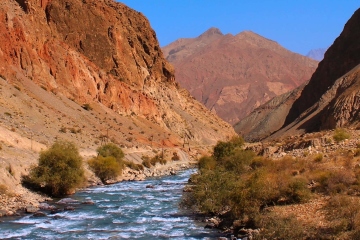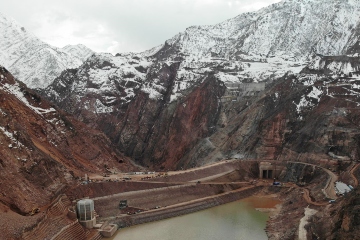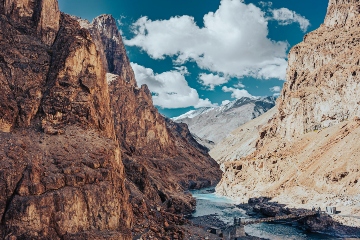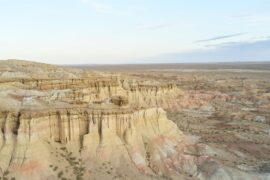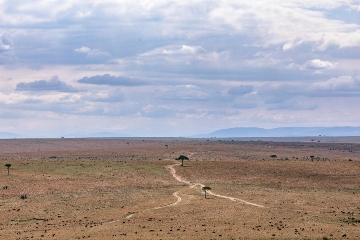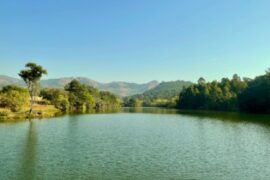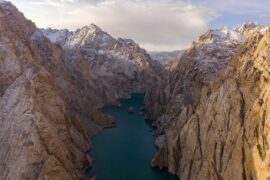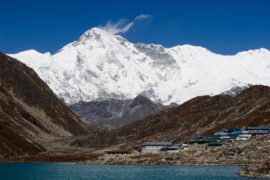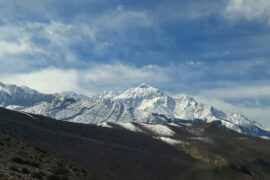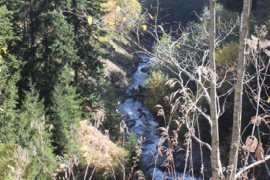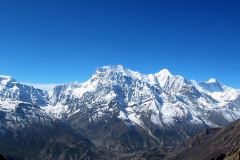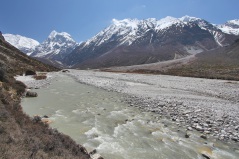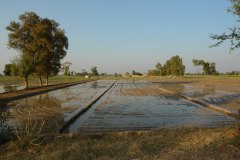Uitdaging
Bergen fungeren als wereldwijde ‘watertorens’ die water opslaan en afvoeren naar stroomafwaarts gelegen gebieden, waar ze in de behoeften van mens en mileu voorzien. In vergelijking met benedenstroomse gebieden genereren bergen een veel grotere afvoer vanuit ografische neerslag en vertragen ze het vrijkomen van water door het op te slaan in sneeuw en gletsjers. Vanwege hun buffercapaciteit, bijvoorbeeld door gletsjersmeltwater te leveren tijdens het hete en droge seizoen, zorgen bergen voor een relatief constante watervoorziening van stroomafwaartse gebieden (Immerzeel et al., 2019; Viviroli et al., 2003). Dit water wordt gebruikt om ecosystemen te onderhouden, gewassen te irrigeren en voedsel te produceren (Biemans et al., 2019), voor huishoudelijke en industriële doeleinden, en om het grootste deel van de beschikbare waterkracht op te wekken (Gernaat et al., 2017; Hoes et al., 2017).
Bergketens zijn kwetsbare systemen: klimaatverandering treft harder op grote hoogte, waar de temperatuur sneller stijgt dan in de omliggende laaglanden (Pepin et al., 2015), en beïnvloedt de opslag van water als gletsjerijs en sneeuw (Kraaijenbrink et al., 2017). Dit leidt tot veranderingen in hydrologische regimes met seizoensverschuivingen en snellere hydrologische respons (Huss and Hock, 2018; Lutz et al., 2014). Aan de andere kant zal de druk op de hoge bergwatervoorraden toenemen met de toenemende stroomafwaartse watervraag onder sociaal-economische ontwikkeling. Klimaatverandering leidt ook tot een toename van extreem weer in bergen, die nu al worden gekenmerkt door frequent extreem weer. Dit verhoogt het risico op overstromingen en aardverschuivingen sterk.
Samenvattend zijn berggebieden en hun benedenstroomse gebieden onderhevig aan sterke toekomstige veranderingen, waar rekening mee moet worden gehouden bij de aanpassing aan de klimaatverandering en investeringsbeslissingen.
FutureWater-aanpak
FutureWater heeft een unieke, wereldwijd toonaangevende expertise op het gebied van berghydrologie. Deze expertise wordt gebruikt in onderzoek en consultancy, waarbij we regelmatig ons hydrologische model Spatial Processes in Hydrology (SPHY) inzetten, dat specifieke sterke punten heeft in het simuleren van hydrologie in de hoge bergen waar betrouwbare gegevens schaars zijn. We ontwikkelen prognoses over toekomstige waterbeschikbaarheid; geven gedetailleerd inzicht in verwachte verschuivingen van seizoensinvloeden voor de watervoorziening en kunnen beoordelen hoe deze aansluiten bij toekomstige veranderingen in de watervraag. Voor de waterkrachtsector bieden we gedetailleerde analyses over toekomstige stroom- en energieopwekking waarin projecties over klimaatverandering zijn meegenomen waarmee investeringen in waterkracht klimaatrobuust kunnen worden onderbouwd. Daarnaast bieden we klimaatrisicobeoordelingen in bergachtige regio’s voor een reeks sectoren. We bieden onderzoek en advies op verschillende schaalniveau’s variërend van lokale kleinere stroomgebieden tot meervoudige rivierstroomgebieden van de grootste rivieren op aarde. Onze beoordelingen stoppen niet bij de overgang van hoogland naar laagland, maar we leggen de link tussen de bovenstroomse en benedenstroomse gebieden om een geïntegreerd advies te kunnen geven, rekening houdend met de volledige zogenaamde water-voedsel-energie nexus.
Gerelateerde projecten
-
Water Supply-Demand Gap analysis for Rogun Dam
The Rogun Hydropower Plant Project (HPP) is a large project (3,780MW) under construction located on the Vakhsh River located about 110 km East-Northeast of Dushanbe, the capital of Tajikistan. It is a Project that will have a large reservoir capable of providing seasonal regulation. It will supply firm energy during...
-
Climate Risk Assessment for the Rogun Dam in Tajikistan
The Rogun HPP is a large project (3,780MW) under construction located on the Vakhsh River in Tajikistan. It will supply firm energy during the winter months when demand for electricity is the highest in Tajikistan and will allow for exports of clean electricity to the Central Asia (CA) region and...
-
Springshed Management in the Indian Himalayas
Springs in the Hindu Kush Himalaya (HKH) region are essential for water security, agriculture, economic activities, ecosystem services, biodiversity, and cultural heritage. They sustain nearly 240 million people, including 50 million in India who depend directly on these springs for their water needs. However, almost half of the perennial springs...
-
Sustainable Water Resources Management in Mongolia
In Mongolia, the continental semi-arid to arid climate of most of the territory results in low water availability, with the southern region particularly affected by a lack of perennial rivers and reliance on fossil groundwater reservoirs, where recharge is negligible. Climate change and increasing water demand are further threatening future...
-
Scientific Support for a Watershed Investment Program for Addis Ababa
Addis Ababa's water supply is under threat caused by the complex interaction of rapid population growth, increased water demand, intensive groundwater development, natural resource degradation, and climate change. A comprehensive Watershed Investment Program should return this situation and secure water supply for the future. An in-depth study is performed to...
-
Integrated Water Resources Management in Tajikistan
Given the abundant freshwater resources in Tajikistan, water plays a crucial role in the country's socioeconomic development. However, the rising population, economic growth, and the growing impacts of climate change pose significant challenges to ensure water availability and accessibility. This project aims to address the aforementioned information gap by improving...
-
GLOW: Global Water Availability Forecasting Service to Support Water Security
The GLOW project aims to pilot an operational service that provides timely and easy access to current and forecasted water availability and demand across the entire Maputo River and the Black Umbeluzi River Basins.
-
WE-ACT: Water Efficient Allocation in a Central Asian Transboundary River Basin
Het algemene doel van het WE-ACT-project is het demonstreren van een beslissingsondersteunend systeem (DSS) voor watertoewijzing in een grensoverschrijdende rivier in Centraal-Azië, om gedeelde voordelen te vergroten en de aanpassing van waterbeheer en -planning aan klimaatverandering te bevorderen.
-
Climate Risk and Adaptation Assessment for Hydropower Project in Nepal
Climate risk and adaptation (CRA) assessment is required for the 635 MW Dudhkoshi hydroelectric project (DKSHEP) to ensure the project addresses climate change mitigation and adaptation in accordance with ADB’s requirements. The initial Climate Risk Assessment (CRA) by FutureWater in 2021 suggested the project is likely to be affected by...
-
Climate Risk and Adaptation Assessment for Nepal’s Power Sector
Nepal’s power sector predominantly relies on hydropower generation. Hydropower is vulnerable to climate change and natural disasters caused by climate change. An understanding of the future impact of climate change on hydropower assets and their performance is important for the successful implementation of hydropower projects. Climate risk and adaptation (CRA)...
-
Development of a Glacio-Hydrological Model and IWRM Plan for the Uttarakhand subbasin in India
The Swiss Agency for Development and Cooperation’s (SDCs) Global Programme Climate Change and Environment (GP CCE) India is supporting the operationalization of climate change adaptation actions in the mountain states of Uttarakhand, Sikkim and Himachal Pradesh through the phase two of the “Strengthening State Strategies for Climate Action” (3SCA) project...
-
Hydrological Assessment for Hydropower in the Lukhra River
The objective was to develop a hydrological assessment for a planned run-of-river hydropower plant in the Lukhra river basin in Georgia. There is no observed river discharge data available. Hence, the assessment was developed based on hydrological simulations of the basin using the SPHY model (Terink et al., 2015) and...
-
Glacio-hydrological Assessment for Hydropower in the Nakhra River
The objective was to develop a glacio-hydrological assessment for planned run-of-river hydropower plant locations in the Nakhraa river basin in Georgia. The availability of observed river flow data is limited. Hence the assessment was developed based on hydrological simulations of the basin using the SPHY model (Terink et al., 2015)....
-
Thought Leader Convening on Water Towers
Scientists from around the world have assessed the planet’s 78 mountain glacier–based water systems and, for the first time, ranked them in order of their importance to adjacent lowland communities, as well as their vulnerability to future environmental and socioeconomic changes. These systems, known as mountain water towers, store and...
-
Pan-TPE: Changes in the Pan-Third Pole Water Tower
The proposed research targets changes in climate, water supply and demand, and suitable adaptation measures for green development of the Silk Road Economic Belt (SREB) in the river basins crossed by the SREB transect. Given the strong role of large scale hydrology in the proposed research activities, the spatial domain...
-
Climate Risk Assessment Using the Decision Tree Framework
The novel methodology that is piloted by the World Bank for assessing climate risks versus other risks on water resource projects, called the Decision Tree Framework (DTF), is applied to two two planned investments: (1) flood protection infrastructure and irrigated cropland expansion on the Nzoia river, Kenya; and (2) the...
-
Hydropower Development Assessment for the Tamakoshi River Basin
The overall objective of this project is to improve the understanding of the expected impacts of climate change on water availability in the context of potential hydropower development in the Tamakoshi River Basin. Specifically, the project aims to (i) Understand the current baseline hydrological regime of the Tamakoshi River Basin,...
-
Review Climate Change Hindu-Kush-Himalaya
FutureWater provided a comprehensive review study on climate change and the impacts on cryosphere, hydrological regimes and glacier lakes in the Indus, Ganges, and Brahmaputra river basins. This review study was done in the context of future hydropower development in the region.
-
HI-AWARE: Himalayan Adaptation, Water and Resilience
HI-AWARE aims to contribute to enhanced adaptive capacities and climate resilience of the poor and vulnerable women, men, and children living in the mountains and flood plains of the Indus, Ganges, and Brahmaputra river basins. Research, including modeling, scoping studies, action research, and randomized control trials, is conducted at 12...
-
Central Asia Regional Risk Assessment for Water Related Energy Sector Impacts
The objective of this study was to support the “Central Asia Regional Energy Sector Vulnerability Study” led by Industrial Economics (IEc) and funded by the World Bank, by carrying out an expanded risk assessment for water availability and water related energy sector impacts in Central Asia. The work built on...
-
Gridded Meteorological Datasets and Hydrological Modelling in the Upper Indus Basin
Understanding of the hydrological regimes in the mountainous Upper Indus basin (UIB) is essential for water resources management in the region. High-resolution gridded meteorological datasets, which capture the spatial variability of precipitation, are critical for modelling the hydrology of high-mountain regions. Improvements to existing gridded datasets using high-elevation station data...
-
Monitoring of Glacier, Climate and Runoff in the Hindu – Kush Himalayan Mountains
For this project a review was conducted of current state of knowledge in (i) climate change datasets and downscaling used for glacier and high mountain modelling, (ii) glacier and snow contribution to river runoff in the Hindu – Kush Himalayan (HKH) region, (iii) hydrological modelling studies used for glacier and...

